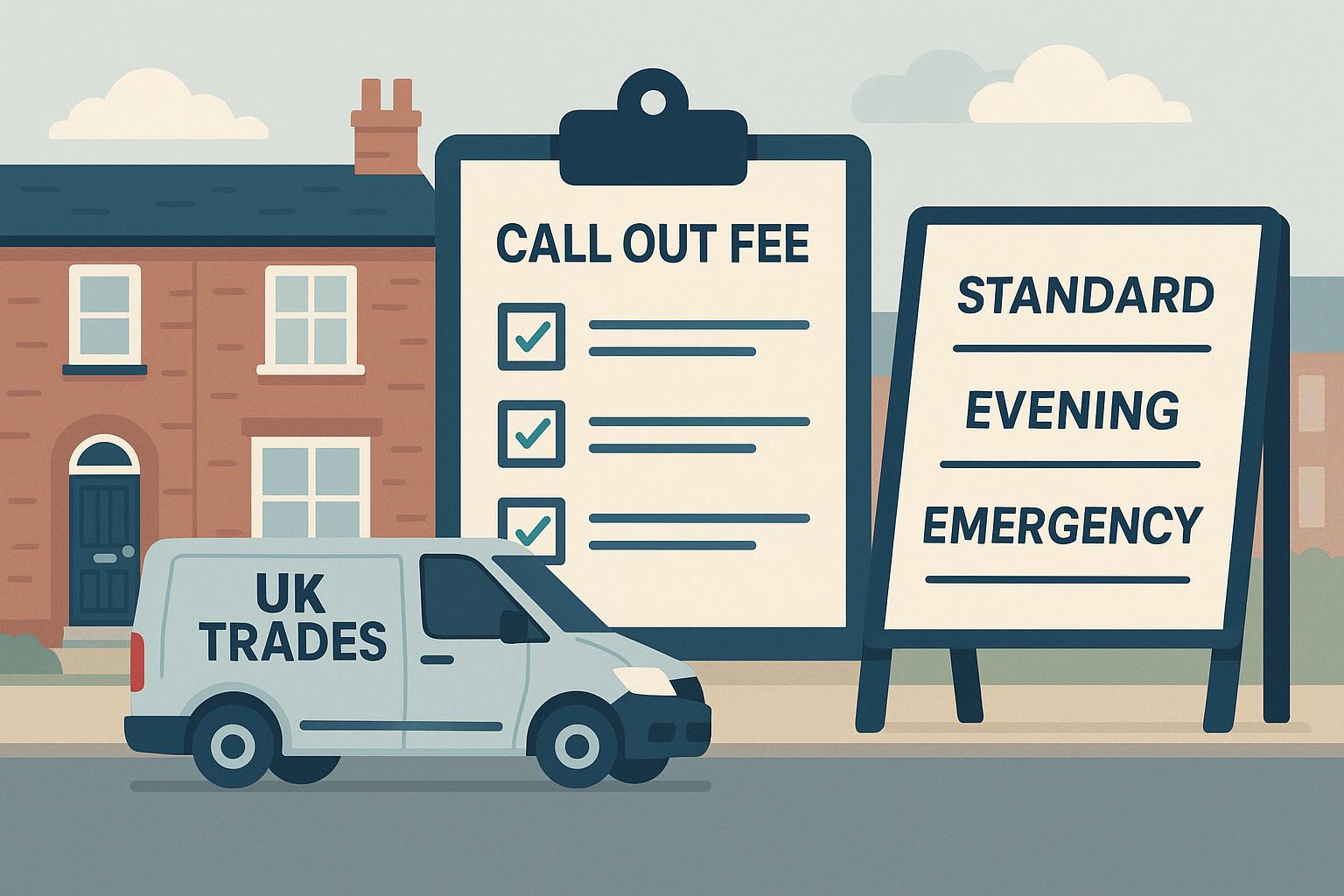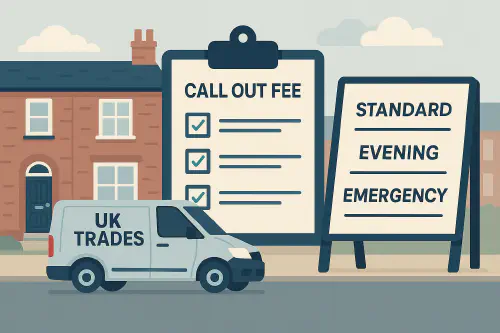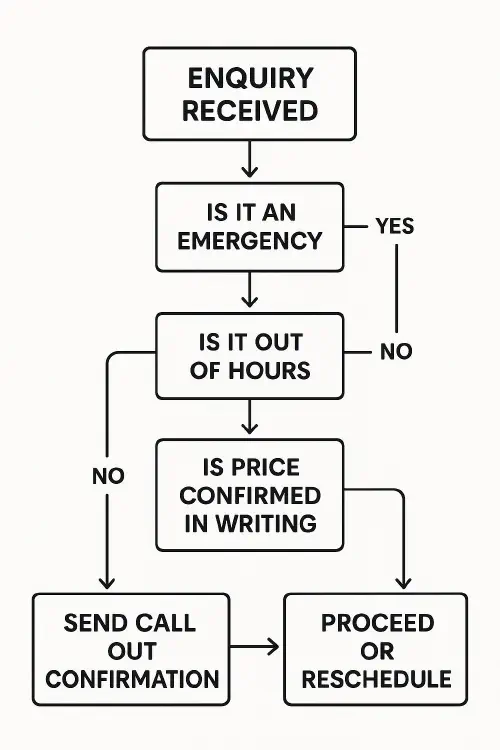
Call-out fee for trades: how to price it, advertise it and stay compliant
Call-out fee for trades: how to price it, advertise it and stay compliant
Category: Business & Operations Niche: pricing, call-out, emergency rates, ASA/Trading Standards, scripts & templates

Illustration of a UK trades van, terraced house and a pricing checklist showing call-out fee tiers
Contents
- Quick answer
- What is a call-out fee and when to charge it
- Set your number: simple, defensible pricing model
- Common models: fixed, refundable diagnostic, tiered and radius-based
- Show it clearly on your website and ads
- Phone script and SMS template to confirm consent
- T&Cs clauses you can adapt
- Emergency and out-of-hours pricing: do it right
- Decision flow: when to charge a call-out
- Typical UK ranges to sanity-check your price
- Mistakes that trigger complaints
- Related Academy guides
- FAQ
Quick answer
- A call-out fee is a flat charge to attend, diagnose and secure the situation. It’s separate from parts and any additional labour unless you state otherwise.
- Typical UK ranges seen publicly: electricians often advertise £80–£150 for attendance including first hour in some cases, and plumbers £70–£160 for standard call-outs with emergency premiums around £100–£120. Always price to your costs and market, not just averages.
- Compliance basics:
- Show VAT-inclusive prices to consumers and include compulsory charges up front.
- If you claim “no call-out”, don’t later bill a “diagnostic” or “attendance” fee when the customer declines work.
- For urgent repairs you’re asked to start immediately, the usual 14-day cooling-off doesn’t apply to that urgent work; still confirm key info and consent.
Helpful sources: ASA call-out claims, Business Companion pricing and Consumer Contracts regulations, and consumer cost guides such as MyBuilder and Checkatrade.
What is a call-out fee and when to charge it
Use a call-out fee to cover:
- Travel time and fuel
- Initial diagnosis and making-safe
- Your overheads (van, insurance, admin)
When it works best:
- Emergencies and out-of-hours
- Low-quality leads where you want commitment
- Remote jobs with travel time you must recover
When to avoid or waive:
- Pre-booked, high-value planned works
- Existing customers with service plans
- When it harms conversion more than it protects margin
Set your number: simple, defensible pricing model
Here’s a no-faff way to arrive at a price you can justify if questioned.
- Calculate your loaded hourly cost
- Direct labour rate you pay yourself/engineer
- Plus burden: NI, holiday, van, fuel, tools, insurance, office
- Example: £22 wage + £18 burden = £40 loaded cost per hour
- Decide what the call-out includes
- Travel + up to 30 minutes on site, or first full hour?
- Making-safe only, or basic fixes too?
- Add your target margin and demand factor
- Base: loaded cost for the included time
- Margin: say 40 to 60 percent on that base
- Demand factor: +25 to 75 percent for evenings/weekends/urgent
Quick formula
- Standard call-out (incl. first 30 min): Loaded cost for 0.75 hours x margin
- Evening: Standard x 1.25
- Emergency 24/7: Standard x 1.5 to 1.75
Document the assumptions in your price file so staff quote consistently and you can defend the rate if challenged.
Common models: fixed, refundable diagnostic, tiered and radius-based
- Fixed call-out (covers first 30–60 min). Clear and simple. Great for first-time fix culture.
- Refundable diagnostic fee. Charge to attend/diagnose, then credit it against the job if the customer proceeds. Reduces no-win visits.
- Tiered by time/urgency. Example: Standard (Mon–Fri, 8–5), Evening (5–9), Emergency (9–8, weekends/hols).
- Radius-based. Different call-out for zones (0–5 miles, 5–15, 15+). Use only if your service area is wide and fuel/time vary a lot.
Pro tip: Pick one model and stick to it in all places customers see prices. Inconsistent messaging is what draws complaints.
Show it clearly on your website and ads
Copy example (edit to your numbers):
- Standard call-out (includes attendance and up to 30 minutes on site): £95 inc VAT. Additional time £30 per half hour.
- Evening call-out (5–9pm): £120 inc VAT.
- Emergency call-out (overnight/weekends/bank hols): from £150 inc VAT.
- If you proceed with our quote after diagnosis, we credit the call-out fee against the final bill on the same visit.
House rules to avoid ASA/Trading Standards issues:
- Always show VAT-inclusive totals to consumers.
- Put the call-out alongside the hourly rate, not buried below the fold.
- If you use “no call-out fee”, ensure customers can decline work without any attendance/diagnostic charge.
- Avoid drip pricing: don’t reveal unavoidable fees late in the journey.
Phone script and SMS template to confirm consent
Phone script (reception/engineer)
- “We can attend today between 2 and 4. The call-out is £95 including VAT. That covers attendance and up to 30 minutes to diagnose and make the area safe. If you go ahead with our quote afterwards, we credit the £95 on the same visit. Does that sound okay?”
- “Great. I’ll text you a confirmation now with the fee and our arrival window. Please reply YES to confirm.”
Follow-up SMS template
- “Booking confirmed: Standard call-out £95 inc VAT, includes attendance + up to 30 minutes. Extra time £30 per half hour. We’ll arrive 2–4 today. Reply YES to confirm.”
Why it matters: you’ve set expectations, gained express consent to charges and created a durable record.
T&Cs clauses you can adapt
Fixed call-out (covers first 30 minutes)
- “Call-out fee: £95 including VAT covers attendance and up to 30 minutes to diagnose and make-safe. Additional time is charged at £30 per half hour. Parts and further labour are quoted before work proceeds.”
Refundable diagnostic
- “Diagnostic fee: £95 including VAT to attend and diagnose. If you accept our quotation for remedial work during the same visit, we credit the diagnostic fee against the job. If you decline, only the diagnostic fee is payable.”
Cancellation/attendance
- “If you cancel after our engineer has departed, the call-out fee applies. For non-urgent bookings within 14 days arranged by phone/online, you may cancel before we start work; where you asked us to start within that period, a proportionate charge may apply for work done.”
Emergency and out-of-hours pricing: do it right
- Urgent repairs requested by the customer can limit cooling-off rights for that urgent work; still send a clear confirmation and price.
- Out-of-hours premiums are fine if they’re transparent and consistently applied.
- If you begin work within the 14-day window at the customer’s request, keep their consent in writing (text/email) and charge only for work actually done if they then cancel.
Useful reading:
- ASA guidance on call-out claims asa.org.uk
- Business Companion on pricing and consumer contracts businesscompanion.info
Decision flow: when to charge a call-out

Flowchart: enquiry → emergency? → out of hours? → confirm price in writing → send confirmation → proceed or reschedule
Typical UK ranges to sanity-check your price
Illustrative public ranges from UK sources:
- Electricians: many list call-out or first-hour rates around £80–£150 depending on urgency and location. See cost guides and rate pages from providers like MyBuilder, Allied Electrical, King Electricians and HaMuch.
- Plumbers: standard call-out often £70–£160; emergency premiums commonly £100–£120+. See guides from Checkatrade, MyBuilder, Taskrabbit and independent rate pages.
Use these as a sense-check only; your price should reflect your costs, service level and area.
External reading:
- Electricians’ fees roundups: MyBuilder, HaMuch, Allied Electrical, King Electricians
- Plumbers’ fees roundups: Checkatrade, MyBuilder, Taskrabbit
Mistakes that trigger complaints
- Advertising “no call-out” but charging a diagnostic/attendance fee if the customer declines work
- Hiding VAT or unavoidable extras until late in the process
- Pre-ticked add-ons or default extras
- Adding card surcharges to consumer jobs
- Conflicting prices across your website, leaflets and Google Business Profile
Related Academy guides
- Estimate vs quote: when to send each and avoid disputes read it
- Set up an AI receptionist that books jobs and reads your price script read it
- Get customers to send pictures for a quote on WhatsApp read it
FAQ
What is a reasonable call-out fee for an electrician or plumber?
There’s no fixed national rate. Many electricians advertise £80–£150 and plumbers £70–£160 for standard attendance, with emergency pr…